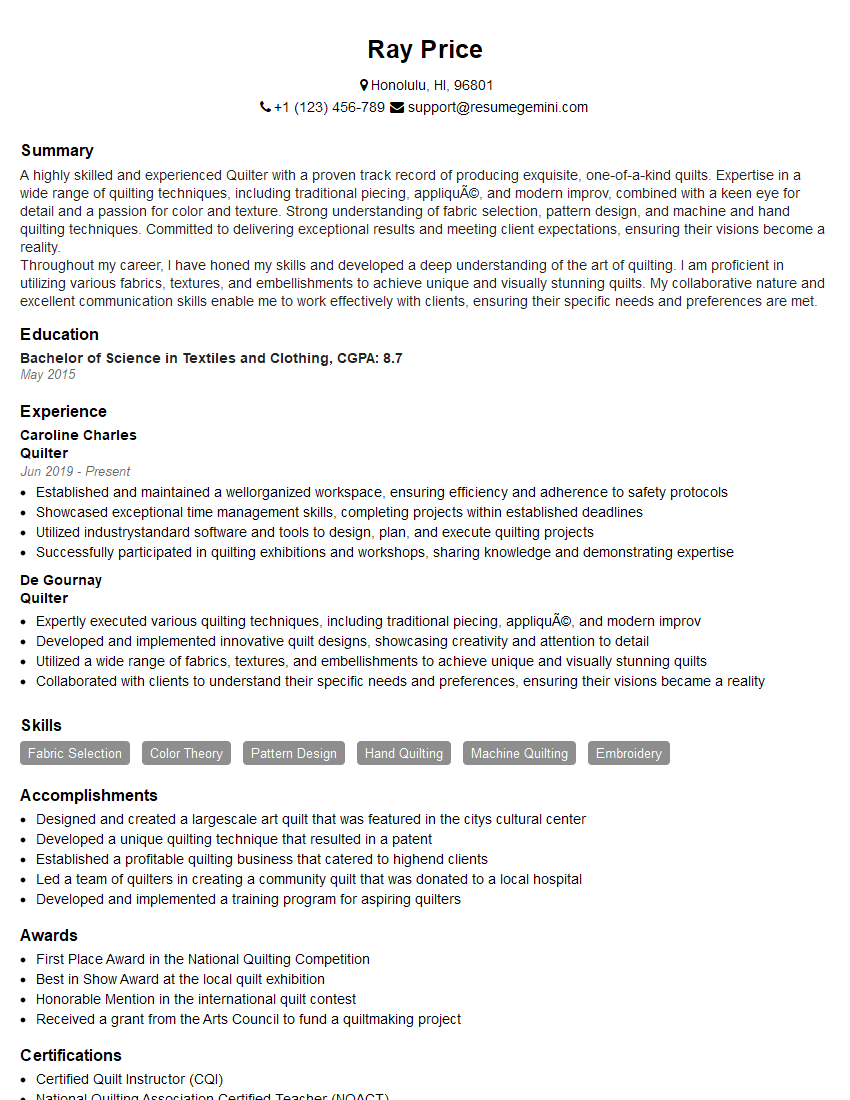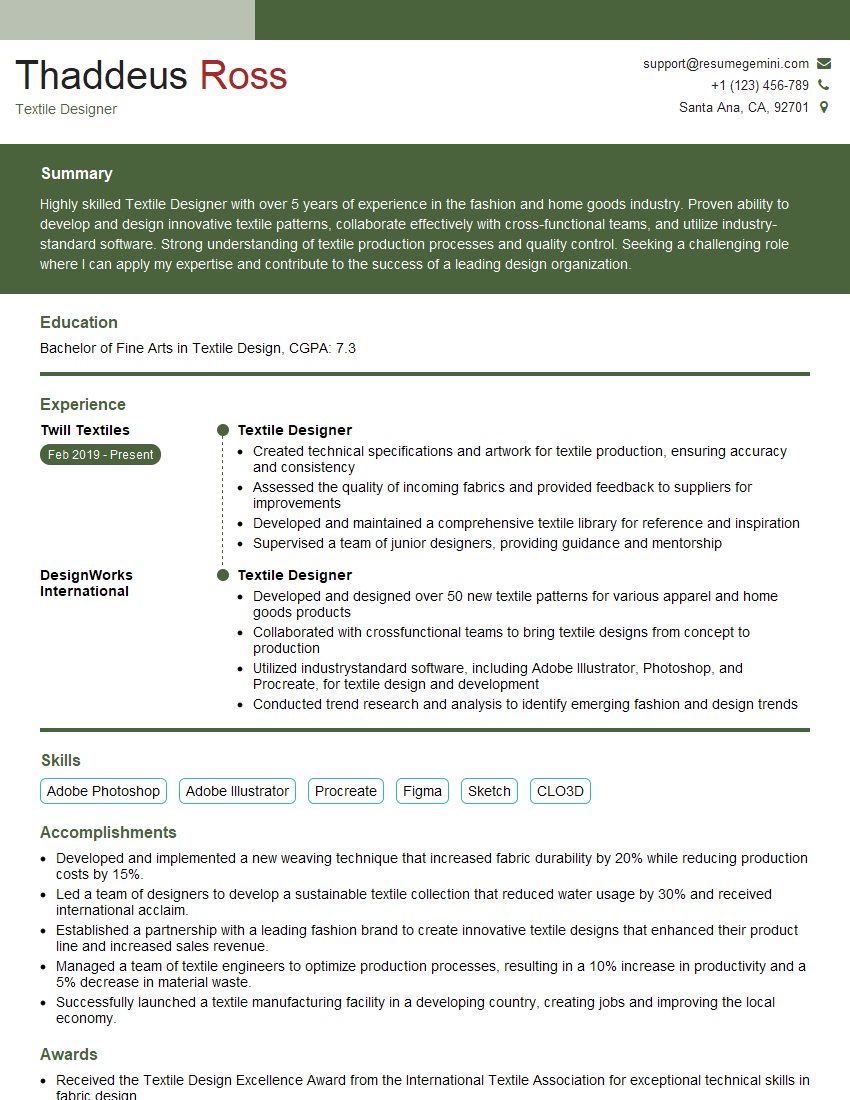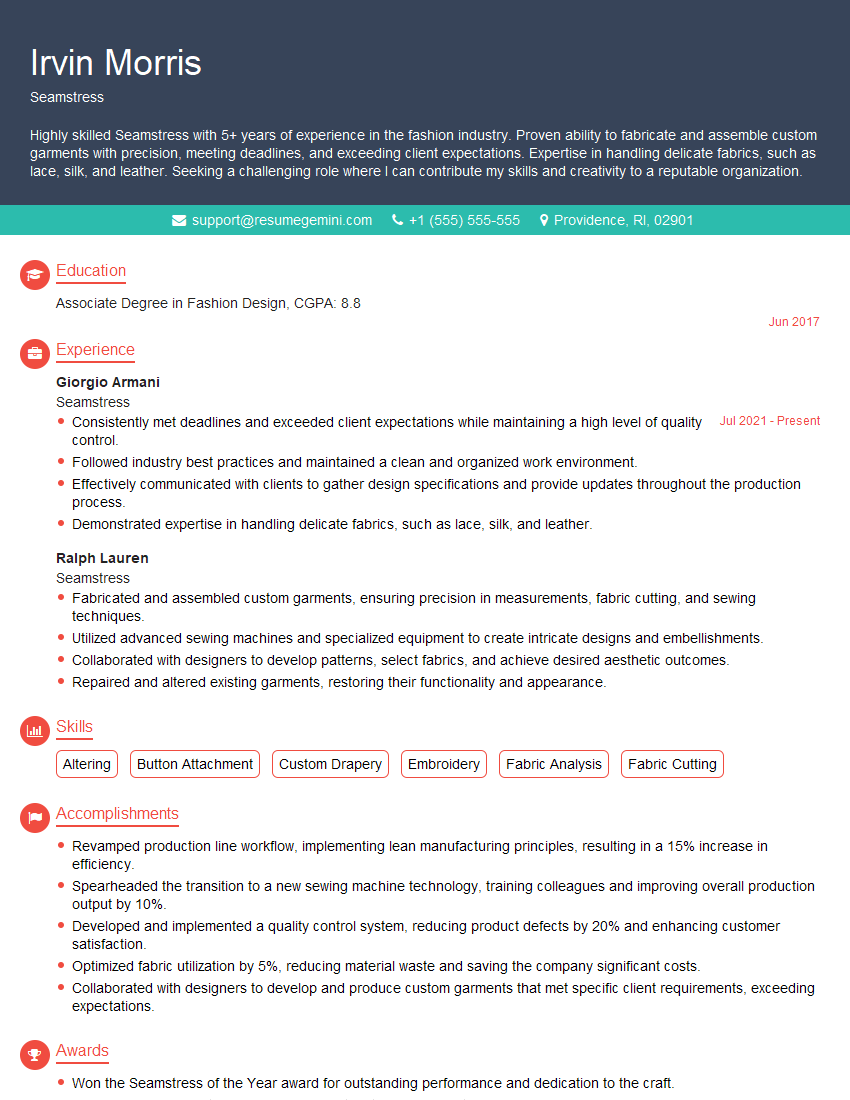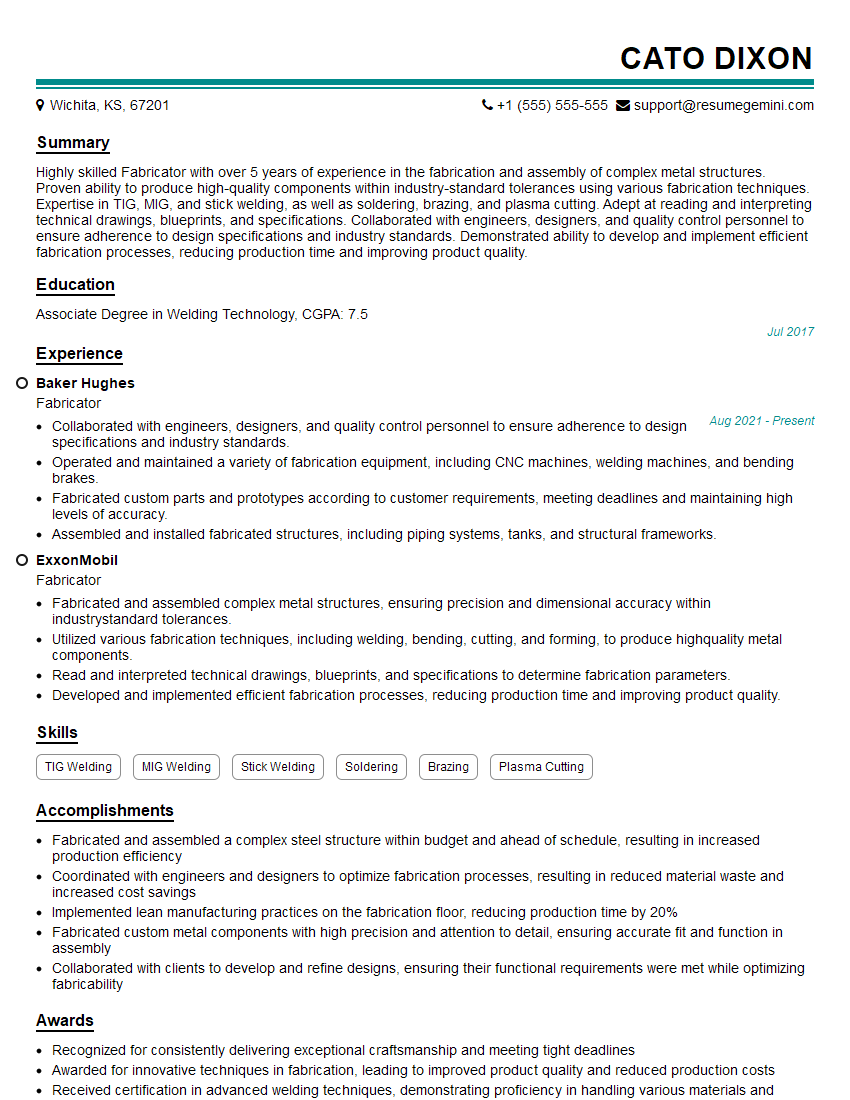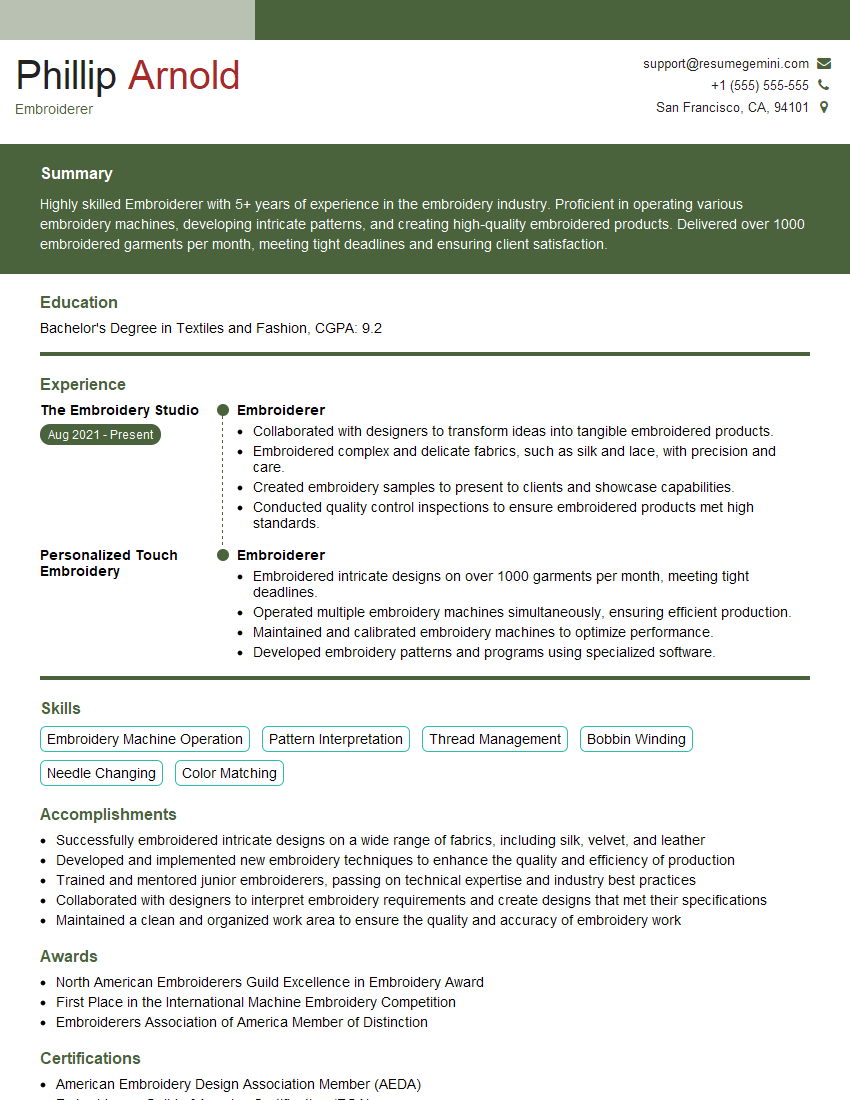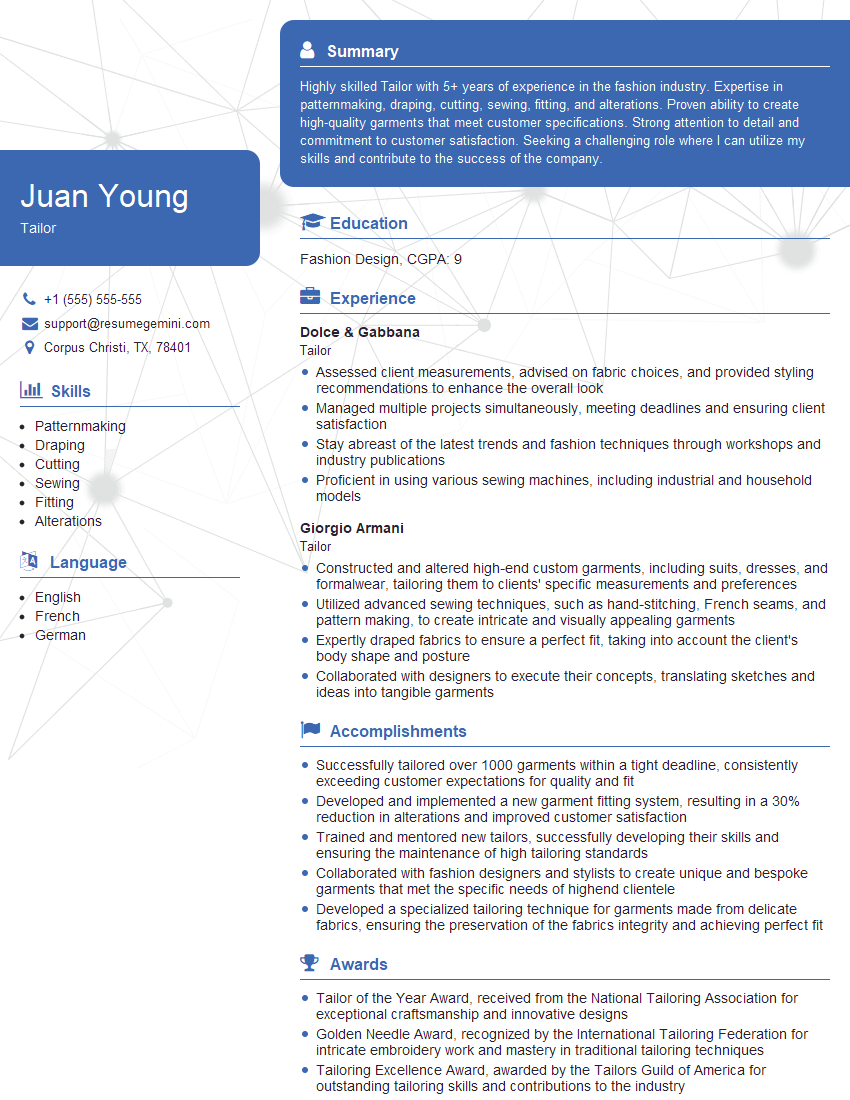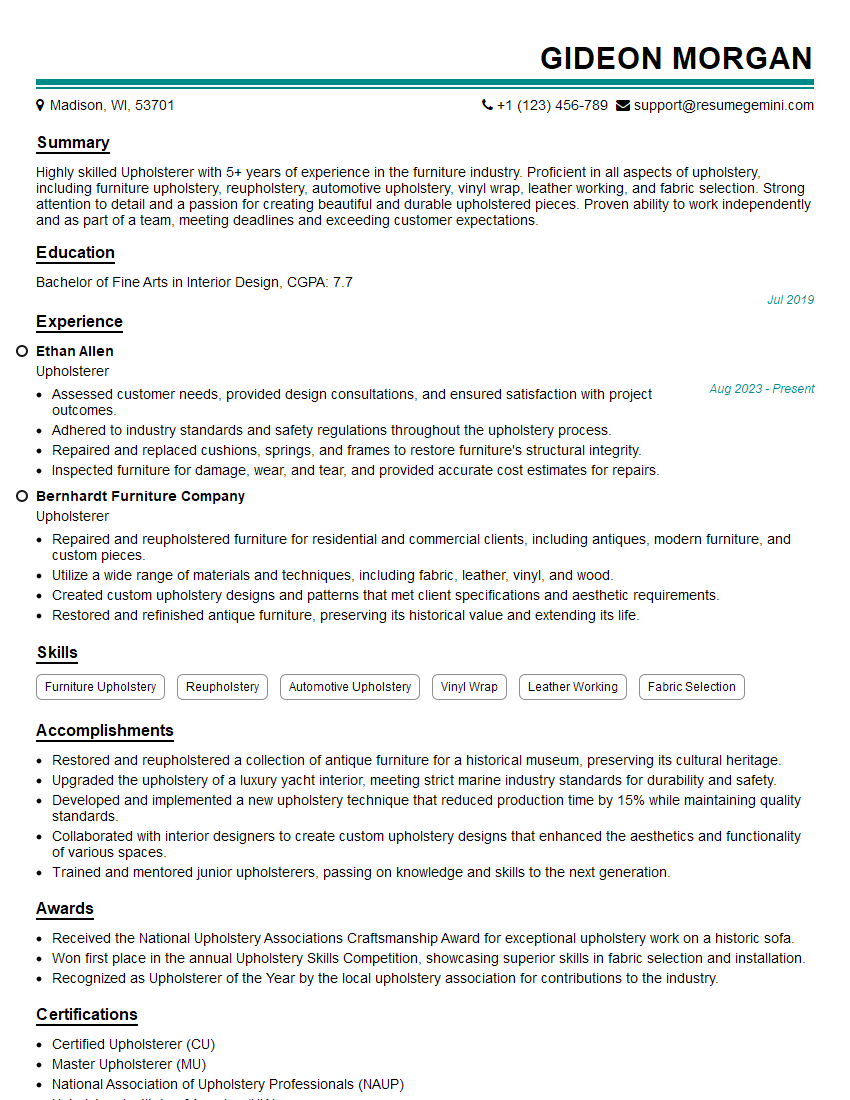Interviews are more than just a Q&A session—they’re a chance to prove your worth. This blog dives into essential Experience with Sewing and Fabricating interview questions and expert tips to help you align your answers with what hiring managers are looking for. Start preparing to shine!
Questions Asked in Experience with Sewing and Fabricating Interview
Q 1. What types of sewing machines are you proficient with?
My proficiency spans a range of sewing machines, from basic domestic machines to advanced industrial models. I’m experienced with both mechanical and computerized machines, understanding their nuances and capabilities. For example, I’m adept at using industrial flatlock machines for creating durable and aesthetically pleasing seams on sportswear, and I’m equally comfortable using a serger for finishing raw edges efficiently. My experience also includes working with specialized machines like buttonhole attachments and embroidery machines for intricate detailing.
- Domestic Sewing Machines: I’m familiar with brands like Singer, Brother, and Janome, understanding their various stitch functions and tension adjustments.
- Industrial Sewing Machines: I have extensive experience operating high-speed, heavy-duty industrial machines used in mass production, including single-needle and double-needle machines for straight stitching, as well as overlock and coverstitch machines.
- Specialized Sewing Machines: I’ve worked with machines dedicated to specific tasks like buttonhole sewing, embroidery, and quilting, each requiring its own unique skill set and understanding of settings.
Q 2. Describe your experience with different fabric types and their properties.
Working with diverse fabrics is fundamental to my skillset. Understanding fabric properties—like drape, weight, weave, and fiber content—is crucial for selecting the right machine settings, needles, and seam finishes. For instance, delicate silks require a fine needle and low machine speed to avoid damage, while heavy canvas demands a sturdy needle and strong stitching.
- Natural Fibers: I’m experienced with cotton (various weights), linen (its tendency to wrinkle), wool (its thickness and resilience), silk (its delicate nature), and rayon (its smooth drape).
- Synthetic Fibers: I’ve worked extensively with polyester (its durability and wrinkle resistance), nylon (its strength), and acrylic (its softness).
- Fabric Blends: I understand how different fiber blends combine properties, such as cotton/poly blends offering durability and ease of care.
This knowledge allows me to anticipate challenges—for example, knowing that stretchy fabrics require specific needles and stitch types to prevent breakage.
Q 3. How do you handle fabric imperfections during the sewing process?
Fabric imperfections are inevitable. My approach focuses on identifying the issue and implementing the most appropriate solution. Minor flaws like loose threads are easily addressed, while larger imperfections may require creative problem-solving. For example, a small hole can often be darned or patched invisibly, and significant damage might necessitate pattern adjustments or using a contrasting fabric to create a design element.
- Loose Threads: These are easily trimmed.
- Small Holes or Tears: These can be mended using a darning needle and thread matching the fabric.
- Stains: Pre-treatment is crucial before sewing; sometimes the stain is simply hidden through strategic placement of design elements.
- Uneven Weave: Careful cutting and seam allowances can often compensate for unevenness.
The key is to assess the imperfection and choose the least disruptive, most aesthetically pleasing solution. My experience allows me to make these judgments quickly and effectively.
Q 4. Explain your experience with pattern making and grading.
Pattern making and grading are essential for creating well-fitting garments. My experience includes drafting patterns from scratch using various methods, including draping and flat pattern design. I’m also proficient in grading patterns to create different sizes, ensuring consistent proportions across the size range. This involves understanding the body’s proportions and how they change with size.
For example, I can draft a basic bodice block, then use this to create various styles like a shirt, dress, or jacket. Grading allows me to create sizes from XS to XXL, ensuring each size maintains the correct proportions.
I utilize both manual and digital pattern-making techniques (CAD software) for efficiency and precision.
Q 5. What are your preferred methods for seam finishing?
Choosing the right seam finish is crucial for garment durability and aesthetics. My preferred methods vary depending on the fabric type and garment style. For example, delicate fabrics benefit from French seams, while heavier fabrics might use a serger finish.
- Serging/Overlocking: Provides a professional, stretchy finish, ideal for knits and woven fabrics.
- Zigzag Stitch: A simple yet effective way to prevent fraying, suitable for most fabrics.
- Pinking Shears: A quick and easy way to finish raw edges, though not suitable for all fabrics.
- French Seams: A neat, durable finish, especially good for sheer or lightweight fabrics.
- Hong Kong Finish: A clean, elegant finish, mostly used on high-end garments.
My selection process considers both function and aesthetics, ensuring a high-quality, professional finish.
Q 6. How do you ensure consistent quality in your sewing work?
Maintaining consistent quality involves a multi-faceted approach. It begins with careful attention to detail at every stage, from pattern preparation and fabric selection to the final pressing. I use checklists to ensure all steps are followed and regularly review my work to identify areas for improvement.
- Precise Cutting: Using sharp shears and accurate measurements avoids inconsistencies.
- Consistent Stitching: Maintaining uniform stitch length and tension ensures even seams.
- Meticulous Seam Finishing: Ensuring consistent seam allowance and properly executed finishes prevents fraying and maintains garment integrity.
- Quality Control Checks: Regularly inspecting work in progress helps identify and correct errors early.
My commitment to quality is reflected in my attention to every detail, resulting in consistently high-quality garments.
Q 7. Describe your experience with industrial sewing equipment maintenance.
My experience includes regular maintenance and minor repairs of industrial sewing equipment. This includes tasks such as oiling and lubricating moving parts, changing needles and bobbins, and addressing minor mechanical issues. I can also troubleshoot common problems, often preventing costly downtime. For example, I can identify and rectify issues with tension, stitch formation, or needle breakage. I’m not a qualified technician for major repairs, but I can perform essential maintenance to ensure optimal machine performance.
I’m familiar with safety procedures related to industrial sewing equipment and always prioritize safe working practices.
Q 8. What are some common sewing machine troubleshooting techniques you use?
Troubleshooting sewing machines involves a systematic approach. I always start by checking the obvious: is the machine plugged in? Is the bobbin properly wound and inserted? Is the needle correctly installed and not bent? These are often overlooked but solve the majority of problems. Beyond that, I’ll consider the type of issue.
Skipping stitches: This can indicate a dull needle, incorrect tension settings (both upper and lower), lint buildup under the needle plate, or improper threading. I systematically check each, cleaning the machine and adjusting tension as needed.
Broken needles: This might be due to hitting a pin or a hard object in the fabric, using the wrong needle type for the fabric, or improper needle insertion. I always inspect the fabric before sewing and use the appropriate needle for the material.
Jammed machine: This can be caused by a tangled thread, a broken needle, or fabric caught in the feed dogs. Carefully removing the cause is crucial, often requiring a thorough inspection and sometimes disassembly of the machine’s relevant parts.
For more complex issues, I consult the machine’s manual or seek assistance from a qualified repair technician. Over the years, I’ve learned to recognize patterns in problems and quickly identify the most likely cause, saving time and materials.
Q 9. How do you interpret and follow sewing patterns?
Interpreting sewing patterns is a crucial skill. It’s like reading a map for creating clothing. I begin by examining the pattern envelope carefully, noting the size range, the view (style) I’ll be making, and the recommended fabrics. I then lay out all the pattern pieces on a large, flat surface. This lets me see the whole picture before cutting.
Next, I check the instructions thoroughly. Many patterns include diagrams and detailed steps. I’ll often make notes and highlight specific areas I might find tricky or that need special attention. I pay close attention to markings such as notches, grainlines, and seam allowances. Notches, for instance, are crucial for matching seams correctly, ensuring a precise finished product. Grainlines dictate the direction of the fabric, critical for proper drape and fit. Seam allowances are the extra fabric I need to sew, typically around 5/8” or ¾”, that I will trim to finish the seam.
I typically pre-wash my fabric before cutting to avoid shrinkage after completion. I always double-check my measurements and make any adjustments necessary for a proper fit before cutting. Once cut, I organize the pieces and meticulously follow the instructions step-by-step. This methodical approach prevents mistakes and ensures a successful outcome. It’s not just about following the instructions; it’s understanding why certain steps are crucial.
Q 10. Explain your process for creating a garment from a design sketch.
Turning a design sketch into a garment is a multi-stage process. I start by analyzing the sketch thoroughly, noting the style, fit, and details. I then determine the appropriate fabric type, considering factors like drape, weight, and texture. The fabric’s characteristics significantly influence the construction process. Then, I’ll create a pattern using the design sketch as a guide. I will often draft the pattern from scratch or modify an existing one based on my vision. This might involve using a sloper (a basic pattern) as a starting point, then adjusting it until it matches the design.
Next, I cut the fabric according to the pattern pieces I’ve created. This step requires careful attention to detail, ensuring accurate placement and alignment. After cutting, I assemble the garment, carefully following my construction plan, which I would have documented during pattern making. I might use different stitching techniques depending on the area of the garment and its function (e.g., topstitching for decorative purposes, French seams for durability).
Finally, I finish the garment, adding features like hems, facings, and closures. Throughout the process, I meticulously check for proper fit and alignment. This might involve fittings along the way, especially for more complex designs. A successful outcome demands a thorough understanding of patternmaking, sewing techniques, and fabric behavior.
Q 11. Describe your experience with different types of stitching techniques.
My experience encompasses a wide range of stitching techniques, each suited for specific purposes and fabrics.
Straight stitch: The workhorse of sewing, ideal for seams, darts, and basic construction.
Zigzag stitch: Used for finishing raw edges, preventing fraying, and decorative purposes. I adjust the width and length based on the fabric and application.
Overlock stitch: A finishing stitch that simultaneously sews and cuts the fabric edges, preventing fraying and creating a professional finish. Often done with a serger, a specialized sewing machine.
Blind hem stitch: Nearly invisible, creating neat hems on skirts, trousers, or curtains. This requires precise needle placement and tension settings.
French seam: Encloses raw edges, creating a durable and elegant seam, commonly used in high-end garments.
Topstitch: A decorative stitch that adds both visual appeal and reinforcement to seams, often used for adding a design element to garments.
Choosing the right stitch depends heavily on the fabric, the desired outcome (e.g., durability, aesthetics), and the area being sewn. This knowledge allows me to create both functional and visually stunning garments.
Q 12. How do you manage time effectively in a high-volume production setting?
Managing time effectively in a high-volume production setting requires a structured approach. I prioritize tasks based on deadlines and importance, using a combination of planning tools and my own experience to gauge how much time each task will take. I always start by creating a detailed production schedule, breaking down large projects into smaller, manageable tasks. This allows for better tracking of progress and easier identification of potential delays.
I utilize time management techniques like time blocking and the Pomodoro Technique. Time blocking involves scheduling specific tasks for specific time slots, helping maintain focus. The Pomodoro Technique involves working in focused bursts with short breaks, enhancing concentration and productivity. I also maintain a clean and organized workspace to minimize wasted time searching for tools or materials. This streamlined workflow enhances efficiency and ensures meeting deadlines even in high-pressure environments. Collaboration with colleagues is also key. Efficient communication helps avoid bottlenecks and keeps the project moving smoothly. Learning to delegate tasks effectively is just as important as doing them yourself.
Q 13. How do you handle urgent or unexpected changes in a production schedule?
Unexpected changes in a production schedule require flexibility and quick thinking. My first step is to assess the nature and scope of the change. Understanding the impact on the overall schedule is crucial. I then communicate with my team, ensuring everyone understands the revised plan and their roles. We discuss any potential challenges and collaboratively find solutions. This involves prioritizing tasks, re-allocating resources if necessary, and adapting our workflow accordingly.
In some situations, prioritizing tasks based on urgency might involve temporarily setting aside less urgent tasks to address the immediate need. Open communication and transparent decision-making are key to maintaining morale and productivity during such disruptions. I try to anticipate potential problems and build in some buffer time in the schedule to accommodate for unforeseen issues. Using project management software to track progress helps me respond effectively to unforeseen changes, minimizing disruptions and ensuring timely delivery.
Q 14. Describe your experience with working with various sewing notions.
My experience with sewing notions is extensive, encompassing a wide range of items that play a crucial role in garment construction. I’m familiar with various types of needles, selecting the appropriate gauge and type (e.g., ballpoint, sharp) based on the fabric. Different fabrics require different needles for optimal stitching and to prevent damage. Thread selection is another crucial aspect. I choose the correct thread weight, fiber content (e.g., polyester, cotton), and color to match the fabric. The correct thread type ensures appropriate strength and appearance.
Beyond needles and thread, I’m proficient with interfacing, used for reinforcing areas such as collars and buttonholes. I understand the various types of interfacing, including fusible and sew-in, choosing the most appropriate one for each application. Zippers, buttons, and hooks and eyes are routinely used for closures and embellishments; I can select and install them correctly and efficiently. Other notions I regularly utilize include seam rippers, scissors, measuring tapes, pins, and pattern weights, each essential for precise and efficient work. My knowledge of these notions extends to understanding their care and maintenance, ensuring their longevity and continued effectiveness.
Q 15. How familiar are you with CAD software for pattern making?
My experience with CAD software for pattern making is extensive. I’m proficient in several industry-standard programs, including Pattern Design System (PDS), Optitex, and Lectra Modaris. I’m not just familiar with the basic functionalities; I understand how to leverage these tools for advanced techniques like grading, marker making, and generating production-ready patterns. For example, using PDS, I recently streamlined the pattern creation process for a complex garment, reducing production time by 15% by optimizing the marker layout. My skills extend to utilizing the software’s 3D capabilities for virtual prototyping and fit analysis, which allows for early detection and correction of design flaws before physical sample creation, saving both time and resources.
Career Expert Tips:
- Ace those interviews! Prepare effectively by reviewing the Top 50 Most Common Interview Questions on ResumeGemini.
- Navigate your job search with confidence! Explore a wide range of Career Tips on ResumeGemini. Learn about common challenges and recommendations to overcome them.
- Craft the perfect resume! Master the Art of Resume Writing with ResumeGemini’s guide. Showcase your unique qualifications and achievements effectively.
- Don’t miss out on holiday savings! Build your dream resume with ResumeGemini’s ATS optimized templates.
Q 16. Describe your experience with quality control procedures in sewing.
Quality control is paramount in sewing. My approach is multifaceted and begins even before the sewing process starts. I meticulously inspect fabrics for defects like flaws in the weave, inconsistencies in color, or damage. During the production process, I implement a system of regular checks at key stages: after cutting, after each major assembly step, and finally, a comprehensive final inspection. This involves examining seams for even stitching, checking for proper alignment of pattern pieces, and ensuring the garment adheres to the design specifications. For example, I might use a gauge to measure seam allowances to ensure consistency. If a defect is found, I meticulously document it, trace the source of the error, and implement corrective measures to prevent recurrence. This systematic approach ensures consistent quality and minimizes waste.
Q 17. What is your experience with different types of fabric cutting techniques?
My experience encompasses a wide range of fabric cutting techniques, tailored to the specific fabric type and project requirements. I’m skilled in manual cutting, using both shears and rotary cutters, choosing the most efficient method depending on the fabric’s drape and the pattern’s complexity. For example, delicate silks are best cut manually with sharp shears to avoid fraying, while heavier materials like denim lend themselves well to rotary cutting for speed and precision. I also have experience with automated cutting systems, which are particularly beneficial for large-scale production runs. Understanding the nuances of each technique allows me to choose the optimal approach for maximizing efficiency and minimizing fabric waste.
Q 18. How do you maintain a clean and organized workspace?
Maintaining a clean and organized workspace is crucial for efficiency and safety. My approach involves a combination of proactive measures and consistent habits. I begin each day by tidying up any leftover materials and tools from the previous session. I have designated areas for specific tools and materials, and I consistently return them to their assigned places after use. I utilize storage solutions like clear bins and drawers to keep smaller items organized. Regular cleaning, including vacuuming and wiping down surfaces, is also vital to maintain a hygienic work environment and prevent accidents. A well-organized workspace minimizes interruptions, fosters creativity and promotes focus, ultimately leading to better quality work.
Q 19. Describe your experience with different types of pressing and finishing techniques.
Pressing and finishing are critical to achieving a professional finish. My skills include using various pressing tools, from irons and steam presses to specialized equipment like tailor’s ham and sleeve roll. I understand the importance of using appropriate heat settings and techniques depending on fabric type to avoid damage. For example, delicate fabrics require a lower temperature and pressing cloth to prevent scorching. I also employ a range of finishing techniques, such as hand-stitching hems, using binding to neaten edges, and creating professional-looking closures like zippers and buttons. The finishing touches make all the difference in creating a high-quality, well-presented garment.
Q 20. How do you handle challenging or complex sewing projects?
When faced with a complex sewing project, my approach is methodical and systematic. I start by thoroughly reviewing the design specifications, including the pattern, fabric choices, and construction details. I then break down the project into smaller, more manageable tasks. I might create a detailed checklist or flowchart to track my progress and ensure all steps are completed accurately. If I encounter an unexpected challenge, I use a problem-solving framework, drawing on my experience and researching solutions if necessary. For example, if I’m struggling with a particularly tricky seam, I might consult relevant resources like online tutorials or sewing books. Ultimately, my aim is to approach each challenge with patience, precision, and a willingness to learn from new experiences.
Q 21. What are your strengths and weaknesses as a sewer/fabricator?
My strengths lie in my meticulous attention to detail, my proficiency with a wide range of sewing techniques, and my ability to adapt to different projects and challenges. I am highly organized and efficient, and I consistently strive for excellence in my work. One area I’m continually working to improve is my speed, particularly on large-scale production tasks. While I’m meticulous, I recognize the need to enhance my efficiency without compromising quality. I regularly seek out opportunities to learn new techniques and improve my workflow to balance precision with speed.
Q 22. How do you stay updated with new sewing techniques and technologies?
Staying current in the ever-evolving world of sewing and fabrication requires a multi-pronged approach. I actively engage with several key resources to ensure my skills remain sharp and my knowledge base is comprehensive.
Industry Publications and Blogs: I regularly read publications like Threads magazine and various online blogs focusing on sewing techniques, pattern design, and new fabric technologies. These provide insights into the latest trends and innovations.
Online Courses and Workshops: Platforms like Skillshare, Craftsy, and YouTube offer a wealth of educational content. I actively participate in online courses and workshops, focusing on areas where I want to deepen my expertise, such as advanced garment construction or digital pattern making.
Industry Events and Conferences: Attending trade shows and conferences dedicated to textiles and apparel manufacturing allows me to network with other professionals, learn about cutting-edge technologies, and observe demonstrations of new techniques firsthand. These events often feature workshops led by industry experts.
Professional Networks: Engaging with online communities and forums dedicated to sewing and fabrication provides opportunities for collaboration, knowledge sharing, and learning from the experiences of others. I actively participate in these discussions, asking questions and contributing my own expertise.
By combining these methods, I create a dynamic and continuous learning environment, ensuring I remain at the forefront of my field.
Q 23. Describe a time you had to solve a problem related to sewing or fabrication.
During a recent project involving the creation of a complex, intricately beaded evening gown, I encountered a significant challenge. The beading pattern, while visually stunning, proved extremely difficult to execute consistently. The beads were small and the fabric delicate, leading to several instances of broken needles and uneven bead placement.
My initial approach involved meticulously following the pattern, but this proved time-consuming and error-prone. To solve this, I adopted a systematic approach. First, I experimented with different needle types and threads to find the optimal combination for the fabric and beads. Second, I developed a more efficient beading technique, employing temporary stitching to secure the beads in place before final placement, allowing for greater precision and control. Finally, I created a small jig to hold the fabric taut, ensuring consistent tension throughout the process.
This methodical approach, combining experimentation with innovative solutions, allowed me to complete the gown to a high standard, significantly improving both efficiency and quality.
Q 24. How do you prioritize tasks and manage your workload?
Effective task prioritization and workload management are crucial in my line of work. I employ a combination of techniques to ensure all projects are completed efficiently and to a high standard.
Prioritization Matrix: I utilize a prioritization matrix (like the Eisenhower Matrix) to categorize tasks by urgency and importance. This helps me focus on high-impact activities first and delegate or postpone less critical tasks.
Detailed Project Planning: For larger projects, I develop a detailed plan outlining each step, including timelines and resource allocation. This approach provides a roadmap for efficient execution and helps to prevent bottlenecks.
Time Blocking: I allocate specific time blocks for particular tasks, ensuring focused work periods and minimizing distractions. This approach improves efficiency and concentration.
Regular Review and Adjustment: I regularly review my progress and adjust my schedule as needed. This ensures flexibility and allows me to adapt to unforeseen challenges or changes in project requirements.
This multifaceted approach allows me to effectively manage even the most demanding workloads, ensuring consistent productivity and high-quality outcomes.
Q 25. What are your salary expectations?
My salary expectations are commensurate with my experience and skills in the field of sewing and fabrication, as well as the specific responsibilities and compensation structure of this role. I am confident that we can reach a mutually agreeable compensation package that reflects my value and contributions to your organization. I’m open to discussing this further based on a more detailed understanding of the role’s responsibilities and the overall compensation structure within your company.
Q 26. What are your long-term career goals?
My long-term career goals revolve around continuous growth and contribution to the field of textile design and fabrication. I aspire to refine my skills in specialized areas like haute couture construction or advanced pattern cutting. I envision potentially leading a team of skilled artisans or even establishing my own design studio, creating innovative and high-quality garments.
Ultimately, I want to leave a lasting impact on the industry through creative design, skilled craftsmanship, and the mentorship of aspiring designers and fabricators.
Q 27. Why are you interested in this specific role?
I am deeply interested in this specific role because of [Company Name]’s reputation for [mention company’s positive attributes, e.g., innovation, high-quality products, commitment to sustainability, supportive work environment]. The opportunity to contribute my expertise to [mention specific projects or aspects of the role that excite you] aligns perfectly with my career aspirations and allows me to leverage my skills in a challenging and rewarding setting. The collaborative nature of the team, as described in the job description, also particularly appeals to me.
Q 28. Do you have any questions for me?
Yes, I have a few questions. First, could you elaborate on the company’s current projects and how my skills would specifically contribute to their success? Second, what opportunities are there for professional development and advancement within the company? Finally, what is the team dynamic like, and how does the company foster collaboration among team members?
Key Topics to Learn for Experience with Sewing and Fabricating Interviews
- Sewing Machine Operation & Maintenance: Understanding different types of sewing machines, their functionalities, troubleshooting common malfunctions, and performing routine maintenance.
- Fabric Selection & Properties: Knowledge of various fabrics (natural and synthetic), their characteristics (drape, weight, texture), and suitability for different projects. Practical application: Explaining why a specific fabric choice was made for a past project.
- Pattern Making & Alterations: Creating and modifying patterns to fit different body types or design specifications. Practical application: Describing a challenging pattern alteration and your solution.
- Construction Techniques: Mastery of various sewing techniques such as seams (French seams, flat felled seams), closures (zippers, buttons, hooks and eyes), and finishing methods (hems, bindings).
- Fabric Cutting & Layout: Efficiently cutting fabric to minimize waste and ensure accurate pattern placement. Practical application: Describing strategies used for efficient fabric cutting.
- Industrial Sewing Machines: Familiarity with industrial sewing equipment and their operation (e.g., sergers, coverstitch machines). Practical application: Describing experience with high-speed production sewing.
- Quality Control & Inspection: Identifying and addressing defects in sewn products. Practical application: Detailing your quality control process and how you’ve addressed past quality issues.
- Safety Procedures: Adhering to safety regulations and using appropriate safety equipment (e.g., needle guards, eye protection).
- Problem-Solving & Adaptability: Describing how you approach challenges encountered during sewing and fabrication processes, showcasing creative solutions and your ability to adapt to unexpected problems.
Next Steps
Mastering sewing and fabricating skills opens doors to diverse and rewarding career opportunities in fashion, textiles, upholstery, and more. Building a strong resume is crucial for showcasing your expertise and securing your dream job. An ATS-friendly resume ensures your qualifications are effectively communicated to hiring managers. We highly recommend using ResumeGemini to create a professional and impactful resume that highlights your unique skills and experience. ResumeGemini provides examples of resumes tailored to Experience with Sewing and Fabricating to help you craft the perfect application.
Explore more articles
Users Rating of Our Blogs
Share Your Experience
We value your feedback! Please rate our content and share your thoughts (optional).
What Readers Say About Our Blog
Hello,
We found issues with your domain’s email setup that may be sending your messages to spam or blocking them completely. InboxShield Mini shows you how to fix it in minutes — no tech skills required.
Scan your domain now for details: https://inboxshield-mini.com/
— Adam @ InboxShield Mini
Reply STOP to unsubscribe
Hi, are you owner of interviewgemini.com? What if I told you I could help you find extra time in your schedule, reconnect with leads you didn’t even realize you missed, and bring in more “I want to work with you” conversations, without increasing your ad spend or hiring a full-time employee?
All with a flexible, budget-friendly service that could easily pay for itself. Sounds good?
Would it be nice to jump on a quick 10-minute call so I can show you exactly how we make this work?
Best,
Hapei
Marketing Director
Hey, I know you’re the owner of interviewgemini.com. I’ll be quick.
Fundraising for your business is tough and time-consuming. We make it easier by guaranteeing two private investor meetings each month, for six months. No demos, no pitch events – just direct introductions to active investors matched to your startup.
If youR17;re raising, this could help you build real momentum. Want me to send more info?
Hi, I represent an SEO company that specialises in getting you AI citations and higher rankings on Google. I’d like to offer you a 100% free SEO audit for your website. Would you be interested?
Hi, I represent an SEO company that specialises in getting you AI citations and higher rankings on Google. I’d like to offer you a 100% free SEO audit for your website. Would you be interested?
good
